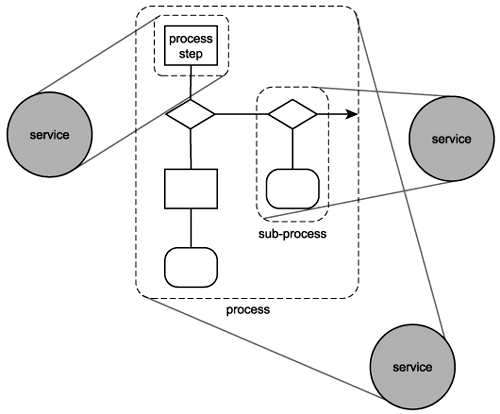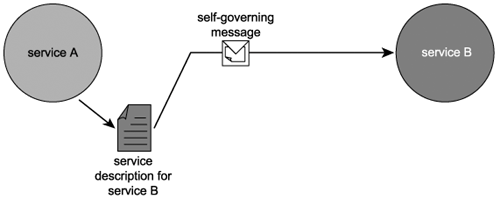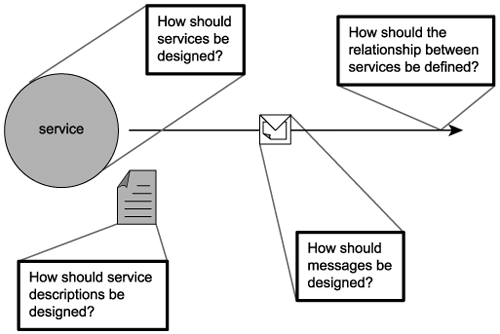Fundamental SOA
Because the term "service-oriented" has existed for some time, it has been used in different contexts and for different purposes. One constant through its existence has been that it represents a distinct approach for separating concerns. What this means is that logic required to solve a large problem can be better constructed, carried out, and managed if it is decomposed into a collection of smaller, related pieces. Each of these pieces addresses a concern or a specific part of the problem.
This approach transcends technology and automation solutions. It is an established and generic theory that can be used to address a variety of problems. What distinguishes the service-oriented approach to separating concerns is the manner in which it achieves separation.
3.1.1. A service-oriented analogy
Let's take your average cosmopolitan city. It is already full of service-oriented businesses. Individual companies are service-oriented in that each provides a distinct service that can be used by multiple consumers. Collectively, these businesses comprise a business community. It makes sense for a business community not to be served by a single business outlet providing all services. By decomposing the community into specialized, individual outlets, we achieve an environment in which these outlets can be distributed.
When coupled with "architecture," service-orientation takes on a technical connotation. "Service-oriented architecture" is a term that represents a model in which automation logic is decomposed into smaller, distinct units of logic. Collectively, these units comprise a larger piece of business automation logic. Individually, these units can be distributed.
Distributing automation logic into separate units is nothing new. What is it then that makes service-oriented separation so different? Much of this book is dedicated to answering that question. However, let's take a preliminary look at some notable distinctions.
Even in a distributed business community, if we impose overbearing dependencies, we could inhibit the potential of individual businesses. Although we want to allow outlets to interact and leverage each other's services, we want to avoid a model in which outlets form tight connections that result in constrictive inter-dependencies. By empowering businesses to self-govern their individual services, we allow them to evolve and grow relatively independent from each other.
Though we encourage independence within our business outlets, we must still ensure that they agree to adhere to certain baseline conventionsfor example, a common currency for the exchange of goods and services, a building code that requires signage to conform to certain parameters or perhaps a requirement that all employees speak the same language as the native consumers. These conventions standardize key aspects of each business for the benefit of the consumers without significantly imposing on the individual business's ability to exercise self-governance.
Similarly, service-oriented architecture (SOA) encourages individual units of logic to exist autonomously yet not isolated from each other. Units of logic are still required to conform to a set of principles that allow them to evolve independently, while still maintaining a sufficient amount of commonality and standardization. Within SOA, these units of logic are known as services.
3.1.2. How services encapsulate logic
To retain their independence, services encapsulate logic within a distinct context. This context can be specific to a business task, a business entity, or some other logical grouping.
The concern addressed by a service can be small or large. Therefore, the size and scope of the logic represented by the service can vary. Further, service logic can encompass the logic provided by other services. In this case, one or more services are composed into a collective.
For example, business automation solutions are typically an implementation of a business process. This process is comprised of logic that dictates the actions performed by the solution. The logic is decomposed into a series of steps that execute in predefined sequences according to business rules and runtime conditions.
As shown in Figure 3.1, when building an automation solution consisting of services, each service can encapsulate a task performed by an individual step or a sub-process comprised of a set of steps. A service can even encapsulate the entire process logic. In the latter two cases, the larger scope represented by the services may encompass the logic encapsulated by other services.
Figure 3.1. Services can encapsulate varying amounts of logic.

For services to use the logic they encapsulate they can participate in the execution of business activities. To do so, they must form distinct relationships with those that want to use them.
3.1.3. How services relate
Within SOA, services can be used by other services or other programs. Regardless, the relationship between services is based on an understanding that for services to interact, they must be aware of each other. This awareness is achieved through the use of service descriptions.
A service description in its most basic format establishes the name of the service and the data expected and returned by the service. The manner in which services use service descriptions results in a relationship classified as loosely coupled. For example, Figure 3.2 illustrates that service A is aware of service B because service A is in possession of service B's service description.
Figure 3.2. Because it has access to service B's service description, service A has all of the information it needs to communicate with service B.

For services to interact and accomplish something meaningful, they must exchange information. A communications framework capable of preserving their loosely coupled relationship is therefore required. One such framework is messaging.
3.1.4. How services communicate
After a service sends a message on its way, it loses control of what happens to the message thereafter. That is why we require messages to exist as "independent units of communication." This means that messages, like services, should be autonomous. To that effect, messages can be outfitted with enough intelligence to self-govern their parts of the processing logic (Figure 3.3).
Figure 3.3. A message existing as an independent unit of communication.

Services that provide service descriptions and communicate via messages form a basic architecture. So far, this architecture appears similar to past distributed architectures that support messaging and a separation of interface from processing logic. What distinguishes ours is how its three core components (services, descriptions, and messages) are designed. This is where service-orientation comes in.
3.1.5. How services are designed
Much like object-orientation, service-orientation has become a distinct design approach which introduces commonly accepted principles that govern the positioning and design of our architectural components (Figure 3.4).
Figure 3.4. Service-orientation principles address design issues.

The application of service-orientation principles to processing logic results in standardized service-oriented processing logic. When a solution is comprised of units of service-oriented processing logic, it becomes what we refer to as a service-oriented solution.
The individual principles of service-orientation are fully explained later in this book. For the purpose of providing a preliminary introduction, let's highlight some of the key aspects of these principles here:
- Loose coupling Services maintain a relationship that minimizes dependencies and only requires that they retain an awareness of each other.
- Service contract Services adhere to a communications agreement, as defined collectively by one or more service descriptions and related documents.
- Autonomy Services have control over the logic they encapsulate.
- Abstraction Beyond what is described in the service contract, services hide logic from the outside world.
- Reusability Logic is divided into services with the intention of promoting reuse.
- Composability Collections of services can be coordinated and assembled to form composite services.
- Statelessness Services minimize retaining information specific to an activity.
- Discoverability Services are designed to be outwardly descriptive so that they can be found and assessed via available discovery mechanisms.
With a knowledge of the components that comprise our basic architecture and a set of design principles we can use to shape and standardize these components, all that is missing is an implementation platform that will allow us to pull these pieces together to build service-oriented automation solutions. The Web services technology set offers us such a platform.
3.1.6. How services are built
As we mentioned earlier, the term "service-oriented" and various abstract SOA models existed before the arrival of Web services. However, no one technology advancement has been so suitable and successful in manifesting SOA than Web services.
All major vendor platforms currently support the creation of service-oriented solutions, and most do so with the understanding that the SOA support provided is based on the use of Web services. Therefore, while we fully acknowledge that achieving SOA does not require Web services, this book's focus is on how SOA can and should be realized through the use of the Web services technology platform.
3.1.7. Primitive SOA
The past few sections have described the individual ingredients for what we call primitive SOA. It is labeled as such because it represents a baseline technology architecture that is supported by current major vendor platforms.
All forms of SOA we explore from here on are based on and extend this primitive model. Some of the extensions we discuss are attainable today through the application of advanced design techniques, while others rely on the availability of pre-defined Web services specifications and corresponding vendor support.
|
SUMMARY OF KEY POINTS |
|---|
|
Introduction
- Why this book is important
- Objectives of this book
- Who this book is for
- What this book does not cover
- How this book is organized
- Additional information
Case Studies
- Case Studies
- How case studies are used
- Case #1 background: RailCo Ltd.
- Case #2 background: Transit Line Systems Inc.
Part I: SOA and Web Services Fundamentals
Introducing SOA
- Introducing SOA
- Fundamental SOA
- Common characteristics of contemporary SOA
- Common misperceptions about SOA
- Common tangible benefits of SOA
- Common pitfalls of adopting SOA
The Evolution of SOA
- The Evolution of SOA
- An SOA timeline (from XML to Web services to SOA)
- The continuing evolution of SOA (standards organizations and contributing vendors)
- The roots of SOA (comparing SOA to past architectures)
Web Services and Primitive SOA
- Web Services and Primitive SOA
- The Web services framework
- Services (as Web services)
- Service descriptions (with WSDL)
- Messaging (with SOAP)
Part II: SOA and WS-* Extensions
Web Services and Contemporary SOA (Part I: Activity Management and Composition)
- Web Services and Contemporary SOA (Part I: Activity Management and Composition)
- Message exchange patterns
- Service activity
- Coordination
- Atomic transactions
- Business activities
- Orchestration
- Choreography
Web Services and Contemporary SOA (Part II: Advanced Messaging, Metadata, and Security)
- Web Services and Contemporary SOA (Part II: Advanced Messaging, Metadata, and Security)
- Addressing
- Reliable messaging
- Correlation
- Policies
- Metadata exchange
- Security
- Notification and eventing
Part III: SOA and Service-Orientation
Principles of Service-Orientation
- Principles of Service-Orientation
- Service-orientation and the enterprise
- Anatomy of a service-oriented architecture
- Common principles of service-orientation
- How service-orientation principles inter-relate
- Service-orientation and object-orientation (Part II)
- Native Web service support for service-orientation principles
Service Layers
- Service Layers
- Service-orientation and contemporary SOA
- Service layer abstraction
- Application service layer
- Business service layer
- Orchestration service layer
- Agnostic services
- Service layer configuration scenarios
Part IV: Building SOA (Planning and Analysis)
SOA Delivery Strategies
- SOA Delivery Strategies
- SOA delivery lifecycle phases
- The top-down strategy
- The bottom-up strategy
- The agile strategy
Service-Oriented Analysis (Part I: Introduction)
- Service-Oriented Analysis (Part I: Introduction)
- Service-oriented architecture vs. Service-oriented environment
- Introduction to service-oriented analysis
- Benefits of a business-centric SOA
- Deriving business services
Service-Oriented Analysis (Part II: Service Modeling)
- Service-Oriented Analysis (Part II: Service Modeling)
- Service modeling (a step-by-step process)
- Service modeling guidelines
- Classifying service model logic
- Contrasting service modeling approaches (an example)
Part V: Building SOA (Technology and Design)
Service-Oriented Design (Part I: Introduction)
- Service-Oriented Design (Part I: Introduction)
- Introduction to service-oriented design
- WSDL-related XML Schema language basics
- WSDL language basics
- SOAP language basics
- Service interface design tools
Service-Oriented Design (Part II: SOA Composition Guidelines)
- Service-Oriented Design (Part II: SOA Composition Guidelines)
- Steps to composing SOA
- Considerations for choosing service layers
- Considerations for positioning core SOA standards
- Considerations for choosing SOA extensions
Service-Oriented Design (Part III: Service Design)
- Service-Oriented Design (Part III: Service Design)
- Service design overview
- Entity-centric business service design (a step-by-step process)
- Application service design (a step-by-step process)
- Task-centric business service design (a step-by-step process)
- Service design guidelines
Service-Oriented Design (Part IV: Business Process Design)
- Service-Oriented Design (Part IV: Business Process Design)
- WS-BPEL language basics
- WS-Coordination overview
- Service-oriented business process design (a step-by-step process)
Fundamental WS-* Extensions
- Fundamental WS-* Extensions
- You mustUnderstand this
- WS-Addressing language basics
- WS-ReliableMessaging language basics
- WS-Policy language basics
- WS-MetadataExchange language basics
- WS-Security language basics
SOA Platforms
Appendix A. Case Studies: Conclusion
EAN: 2147483647
Pages: 150
- Using SQL Data Manipulation Language (DML) to Insert and Manipulate Data Within SQL Tables
- Understanding SQL Transactions and Transaction Logs
- Working with Functions, Parameters, and Data Types
- Understanding Transaction Isolation Levels and Concurrent Processing
- Working with Ms-sql Server Information Schema View
